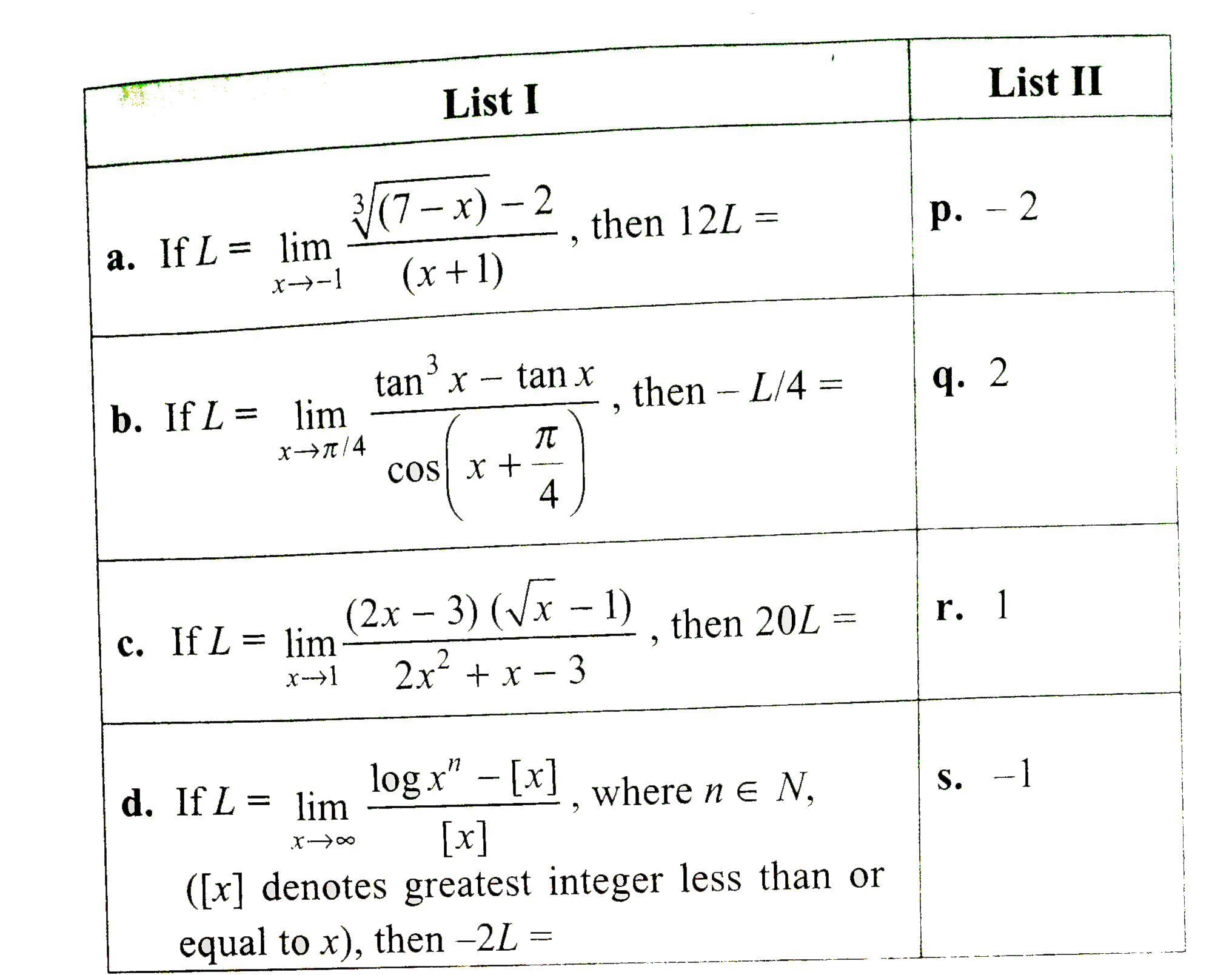If m,n∈N,(lim)x→0sinxm(sinx)mis 1,ifn=m (b) 0,ifn>m ∞,ifn<m (d) nm,ifn<mSolution in Tamil
p2
π2√2
π√2
√2π
The correct Answer is:A, B, C
L=limx→0sinxn(sinx)m=limx→0sinxnxnxn(sinx)mxmxm=limx→0xn−m
If n=m, then
L=(a very small value near to zero)exactly zero=1
If n>m, then
L=(a very small value near to zero)Positive integer=0
If n<m, then
L=(a very small value near to zero)negative integer=∞
Topper's Solved these Questions
- LIMITSBook:CENGAGEChapter:LIMITSExercise:Exercise (Comprehension)
Explore 20 Videos
- LIMITSBook:CENGAGEChapter:LIMITSExercise:Exercise (Matrix)
Explore 5 Videos
- LIMITSBook:CENGAGEChapter:LIMITSExercise:Exercise (Single)
Explore 76 Videos
- JEE 2019Book:CENGAGEChapter:JEE 2019Exercise:Chapter 10
Explore 9 Videos
- LINEAR COMBINATION OF VECTORS, DEPENDENT AND INDEPENDENT VECTORSBook:CENGAGEChapter:LINEAR COMBINATION OF VECTORS, DEPENDENT AND INDEPENDENT VECTORSExercise:DPP 1.2
Explore 10 Videos
Similar Questions
Find the domain of f(x)=√|x|−{x} (where {⋅} denots the fractional part of x).
View SolutionMatch the following lists:

View Solution(lim)x→0[sin(sgn(x))(sgn(x))], where[.] denotes the greatest integer function, is equal to (a)0 (b) 1 (c) −1 (d) does not exist
View SolutionIf y = y(x) is the solution of the differential equation, xdydx+2y=x2 satisfying y(1) = 1, then y(12) is equal to
View SolutionThe number of integral values of p for which (p+1)ˆi−3ˆj+pˆk,pˆi+(p+1)ˆj−3ˆk and −3ˆi+pˆj+(p+1)ˆk are linearly dependent vectors is q
View SolutionIf m,n∈N,(lim)x→0sinxm(sinx)mis 1,ifn=m (b) 0,ifn>m ∞,ifn<m (d) nm,ifn<m
View SolutionIfI(m,n)=∫10xm−1(1−x)n−1dx,(m,n∈I,m,n≥0),then I(m,n)=∫∞0xm−1(1+x)m−ndx I(m,n)=∫∞0xm−1(1+x)m+ndx I(m,n)=∫∞0xn−1(1+x)m+ndx I(m,n)=∫∞0xn(1+x)m+ndx
View SolutionIf Im,n=∫(sinx)m(cosx)ndx then prove that Im,n=(sinx)m+1(cosx)n−1m+n+n−1m+n.Im,n−2
View SolutionIf m,n∈N,limx→0sinxn(sinx)m is
View SolutionThe inflorescence ifn ociumum is
View SolutionIf m,n∈N,(lim)x→0sinxn(sinx)mis (a) 1, if n=m (b) 0, if n>m
View SolutionIfI(m,n)=∫10xm−1(1−x)n−1dx,(m,n∈I,m,n≥0),then (a) I(m,n)=∫∞0xm−1(1+x)m−ndx (b) I(m,n)=∫∞0xm−1(1+x)m+ndx (c) I(m,n)=∫∞0xn−1(1+x)m+ndx (d) I(m,n)=∫∞0xn(1+x)m+ndx
View SolutionIf m,n∈N,limx→0sinxn(sinx)m is
View SolutionLet f:N∪{0}→N∪{0} be defined by f={n+1ifn is evenn−1ifn is odd Show that f is a bijection.
View SolutionIf I(m,n)=∫10tm(1+t)n.dt, then the expression
for I(m,n) in terms of I(m+1,n-1) is:
(a) 2nm+1−nm+1I(m+1,n−1)
(b) nm+1I(m+1,n−1)
(c) 2nm+1+nm+1I(m+1,n−1)
(d) mm+1I(m+1,n−1)
View Solutionα –IFN is used in :-
View Solution
